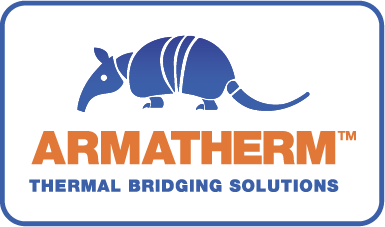
Armatherm
About us
We are a collaborative partner who can address thermal bridging concerns in building designs from the foundation to the roof. We manufacture structural thermal breaks to reduce energy loss within buildings.
We have offices in the US, UK and the European Union.
Europe, North America and the United Kingdom.
We manufacture an extensive product range with each materials providing a combination of low thermal conductivity and high compressive strength. They have been specifically designed and tested to transfer load and prevent thermal bridging.
Armatherm’s FRR material is most commonly used to insulate steel connections that experience high structural loads.
Armatherm’s 500 Series is used within applications where the loads may vary and higher levels or insulation is required.
The ArmaGirt™ Z Girt is a non conductive support which is strong enough to hold most cladding and insulation details.
We have testing standards for ‘Resistance to Moisture / Thermal Transmittance / Fire Resistance / Compressive Strength’. Click here for the most up-to-date test reports and further details.
We maintain high stock levels of all our most popular products.
We keep high stock levels of the most popular materials, and can provide these in sheet form and bespoke sizes.
You can expect delivery within five – ten business days.
GENERAL FAQs
Thermal Bridging
A thermal bridge is a conductive pathway over which heat can travel. A thermal bridge connects a heated or conditioned space with the outside creating unwanted heat loss or heat gain. Thermal breaks bypass the insulation layer.
Thermal bridging within walls can occur via the wall framing, especially with steel wall studs which can act as bridges that let heat or cool air escape.
Within building insulation, there are elements which penetrate the building envelope. These can create thermal bridges which transfer heat or cool air out of a building.
Thermal bridges can occur within several points during construction, any application where a conductive material is used is at risk of causing thermal bridges.
Cold bridging is another term often used to describe thermal bridging, both refer to the transfer of heat or cool temperatures.
To avoid thermal bridges occuring where high conductivity is present such as steel beams, a thermal break can be incorporated which prevents temperatures transferring via conductible materials.
Any sort of thermal or cool bridges can be prevented with the use of the correct thermal break.
Thermal Breaks
To take a look at the full breakdown of each product’s values, download our datasheets here.
A thermal break is a material which harbours low thermal conductivity properties to slow the flow of heat energy via thermal bridges.
A thermal break can be used with a construction to make the building as efficient as possible. They can be used throughout many different areas of a structure thanks to their strength and versatility.
Thermal bridges can occur at several points throughout a building, any application where a conductive material is used can cause temperatures to be transferred.
Masonry applications require tie-backs and shelf angles which form significant thermal bridges. Shelf angles transfer the masonry load back to the buildings’ structural steel or concrete slab edge interrupting the continuous insulation of the wall assembly creating a linear thermal bridge.
When the frame of a building meets with the foundation significant heat loss can occur. By insulating the foundation from the frame energy can be saved.
Incorporating thermal breaks within a project improves the efficiency in areas which are difficult to insulate.
Armatherm’s products can save 70% of energy, depending on the application.
By specifying a thermal break, 30-75% of energy can be saved in areas where thermal bridges occur.
Depending on the plan details, thermal breaks are usually 1 – 4″ thick.
Armatherm’s structural thermal breaks can bear loads between 230psi, and 43,000psi.
Applications/fitting
There are a range of applications which would benefit from a thermal break including cladding attachment, slab edges, doors and window penetrations, roof penetrations like HVAC equipment, davits, dunnage, balconies, canopies, parapets, column bases, foundations.
A parapet roof is an extension of a wall that’s at the edge of a roof, balcony, terrace, walkways, or structure. It’s a short, vertical wall that runs the roofline of any building.
You can insulate parapet transitions with the addition of a thermal break.
You can insulate parapets at the points where the roof meets the wall.
Utilising a high strength, weight bearing thermal break means you can insulate a parapet wall from the roof.
Steel is a highly conductive metal which will transfer significant amounts of energy and heat from inside to outside. Separating them with a thermal break can prevent this.
You can thermally break concrete balconies as they’re engineered with cast-in-situ high strength polyurethane insulation.
A steel balcony will be highly conductive, but with the use of a thermal break energy and heat transfer can be kept to a minimum.
You can insulate concrete walls with the help of nonconductive Z Girt anchors.
Although wood and rubber both have low thermal conductivity properties, they will deflect, creep and potentially misshapen over time.
Thermal breaks are fitted within any applications that require thermal isolation. Available in a number of different products, it depends on the application how these would be fitted.
As thermal breaks may change the dimensions of a plan, they should be specified and included with any planning at the earliest possible stages.
Washers and bushings can be used to further improve the thermal performance of a thermal break. Armatherm has a selection of FRR fixings available.
A thermal break can be inserted under a column to insulate it and reduce heat loss.
A thermal break can be added on top of the footing and over the bolts and anchors with the column resting on top to thermally isolate and insulate the connection.
Roof-top HVAC equipment can be thermally broken at the base connection to the supporting beam.
To insulate roof-top anchors, Armatherm 500 is usually specified, though Armatherm FRR can be used within applications that require maximum strength.
Armatherm 500 is often specified to insulate sill plates and mud sills.
A brick shelf can be thermally broken by inserting a thermal break where the steel angle is bolted to the frame.
Other
If moisture gets into the wall assembly, rainscreen cladding allows for draining and drying.
If moisture gets into the wall assembly, rainscreen cladding allows for draining and drying.
It’s a continuous layer of insulation on the exterior of building that reduces energy transfer between the building and surrounding environments.
Thermal breaks are commonly found at balconies, canopies, parapets, column bases, foundations, cladding attachment, slab edges, doors and window penetrations, roof penetrations like HVAC equipment, davits, dunnage.
Continuous insulation prevents unwanted heat loss and gain, meaning inside temperatures will stay warmer in cool weather and cooler in warm weather.
A thermal barrier and weather barrier should work together.
Dense structural materials usually harbour poor thermal conductivity qualities.
Energy efficiency can be increased in a building with the addition of thermal breaks which reduce thermal bridges and prevent the transfer energy and temperatures.
Product specific
ArmaGirt™ Z Girts
A Z Girt is a structural member, shaped like a Z, that is used for holding insulation, and mounting cladding or siding. Non conductive z girts offer as much as a 75% improvement over traditional steel z girts.
Non conductive z girts provides secure insulation retention for continuous insulation, and a sound surface to permanently connect cladding and siding.
Yes. It is common to shim z girts where necessary.
Mineral wool or polyisocyanurate are most often used with z girts.
Z girts are fast and easy to install, carry many thicknesses of insulation, and cladding. Non conductive Z girts will allow the insulation to perform at a high level.
Z girts come in 7 standard sizes- 1 1/2″, 2″, 2 1/2″, 3″, 3 1/2″, 4″ and 6″
ArmaGirt™ Z Girt can hold all common insulation and all types of cladding except the heaviest.
ArmaGirt™ Z Girt can hold all common insulation and all types of cladding except the heaviest.
ArmaGirt™ Z Girt is attached with weather resistant screws.
ArmaGirt™ Z Girt is attached with weather resistant, self tapping screws.
They can be mounted with self tapping screws.
ArmaGirt™ Z Girt mounts back to the frame of the building with self tapping, weather resistant screws.
Starter or temrmination pieces can be cut and used from Z Girts.
ArmaGirt™ Z Girt is NFPA 285 certified.
This would be dependent on the type of cladding and the local building codes.
The wind rating is based on many factors, including local weather, building height and local building codes.
FRR
Armatherm’s FRR material stands for ‘fabric reinforced resin’, it’s a compressed thermoset resin with impressive insulation properties.
FRR is best suited to be specified in projects with steel to steel connections where high compressive strength is needed.
FRR will be bolted between steel plates to control conductive heat loss or gain. FRR pads are often 1″-4″ thick.
FRR is tested at 300N/mm2 of compressive strength. A 305mm x 305mm steel pad with FRR could take over 6,000,000 pounds of compressive load.
The steel terminated and a plate is welded on, then a thermal break is sandwiched into a bolted connection as the steel continues outside the building. The thickness of the thermal break is dependant on the situation.
Armatherm’s FRR material can improve the efficiency of a building by reducing heat flow out of the envelope.
FRR is stocked in thicknesses from 1/16″ to 2″, but can be bonded to create custom thicknesses to suit whichever measurements you require.
Should be protected from fire and can be used in areas that are <175 degrees F.
Either, FRR can be drilled on site but Armatherm can provide custom cutting and drilling to make sure it’s sent to site at the correct measurements.
The bolt specs will be decided by the engineer.
Not at all, but they must be specified within the early stages of a project.
The spec of the bolts will be decided by the engineer.
Armatherm’s washers and bushings reduce the steel to steel contact to improve efficiency and reduce bridging.
Armatherm™ 500
The series ranges from 500-80, 230psi at R-3.85 to 500-280, 2150psi at R-1.9. The lower the compression strength, the higher the R-value will be.
Armatherm 500 is made from an ultra high density polyurethane.
The 500 series is made from polyurethane which is considered foam.
The 500 series has many uses as a structural thermal break, it can be used
anywhere a penetration or transition exists in the building envelope creating a thermal bridge.
Armatherm 500 is easy to install, can be cut and drilled to shape and offers incredible insulating values.
The thicknesses includes 1/2″, 1″, 2″ and can be bonded to any thickness.
Armatherm 500 comes in 4’X8′ sheets, or can be drilled and cut to bespoke sizes.
Armatherm can work to your plans, cutting and drilling accordingly where required.
The 500 range can withstand 230psi to 2150psi.
When specified properly, 500 will not crush over time.
The Armatherm 500 series ranges from 500-80, 230psi at R-3.85 to 500-280, 2150psi at R-1.9. The lower the compressive strength, the higher the R value will be.
